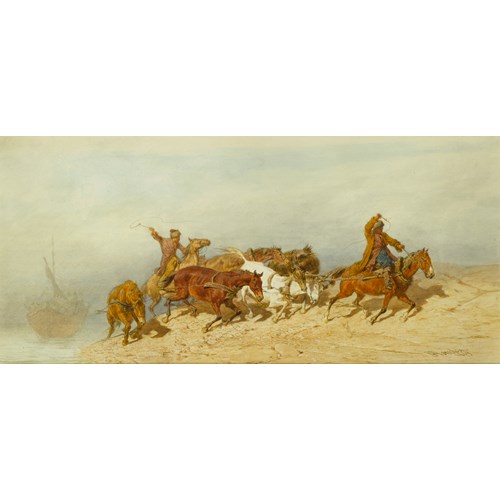Marketplace
The Cathedral of the Dormition, Moscow
Henry Charles Brewer
The Cathedral of the Dormition, Moscow
Epoque 1850-1900, 19th century, 20th century
Origine England
Medium Watercolour on paper
Dimension 32 x 45 cm (12⁵/₈ x 17³/₄ inches)
Bathed in dazzling sunlight, the Cathedral of the Dormition stands peacefully on the Cathedral Square of the Moscow Kremlin. Against the background of bright blue sky, the building has a splendid appearance. The sun illuminates the five golden domes of the cathedral, which endows the impressive structure with a majestic character. The watercolour does, however, remain faithful to reality.
In this work, the square is full of people arriving to attend a religious service. Visitors have come on foot or by horse and wagon. Some coachmen wait in the shadow of neighbouring buildings and others enjoy the sun, while their masters go inside. With the service about to begin, the crowd has gathered around the Cathedral’s entrance as the clergy enters. They are dressed in red robes and bear aloft a Khorúgus, a religious banner which depicts either an icon of Christ, an image of the Theotokos, or a Saint. The clergy and faithful are entering the cathedral through the south portal, which was the entrance used for royal processions. The portal is decorated with seventeenth-century frescoes.
The Cathedral of the Dormition was used not only for daily services and religious celebrations, but for more important events such as the coronation of Russian Emperors and the ritual installation of metropolitans and patriarchs of the Russian Orthodox Church. The coronation of the first Russian Tsar, Ivan the Terrible (1530-1584) took place in this cathedral in 1547. When the Bolsheviks came to power in Moscow, all services in the Kremlin Cathedrals were forbidden. The final Easter service was held in the Cathedral in 1918 with Vladimir Lenin’s (1870-1924) special permission. It has been suggested however, that Joseph Stalin (1878-1953) later ordered a secret service, to be held in the Cathedral in the winter of 1941, to pray for the country’s salvation from the Nazis, who had just reached the outskirts of Moscow. In 1990, the Cathedral was returned to the Church, although a large museum still operates within it today.
Henry Charles Brewer was the son of Henry William Brewer (active 1858-1903) who was also an artist. He studied at Westminster School and lived in London where he painted many urban scenes. He exhibited at the Fine Art Society and the Royal Academy between 1899 and 1902. A member of the Royal Institute of Painters in Water Colours, he was elected to the Royal Institution of Great Britain in 1914.
In this work, the square is full of people arriving to attend a religious service. Visitors have come on foot or by horse and wagon. Some coachmen wait in the shadow of neighbouring buildings and others enjoy the sun, while their masters go inside. With the service about to begin, the crowd has gathered around the Cathedral’s entrance as the clergy enters. They are dressed in red robes and bear aloft a Khorúgus, a religious banner which depicts either an icon of Christ, an image of the Theotokos, or a Saint. The clergy and faithful are entering the cathedral through the south portal, which was the entrance used for royal processions. The portal is decorated with seventeenth-century frescoes.
The Cathedral of the Dormition was used not only for daily services and religious celebrations, but for more important events such as the coronation of Russian Emperors and the ritual installation of metropolitans and patriarchs of the Russian Orthodox Church. The coronation of the first Russian Tsar, Ivan the Terrible (1530-1584) took place in this cathedral in 1547. When the Bolsheviks came to power in Moscow, all services in the Kremlin Cathedrals were forbidden. The final Easter service was held in the Cathedral in 1918 with Vladimir Lenin’s (1870-1924) special permission. It has been suggested however, that Joseph Stalin (1878-1953) later ordered a secret service, to be held in the Cathedral in the winter of 1941, to pray for the country’s salvation from the Nazis, who had just reached the outskirts of Moscow. In 1990, the Cathedral was returned to the Church, although a large museum still operates within it today.
Henry Charles Brewer was the son of Henry William Brewer (active 1858-1903) who was also an artist. He studied at Westminster School and lived in London where he painted many urban scenes. He exhibited at the Fine Art Society and the Royal Academy between 1899 and 1902. A member of the Royal Institute of Painters in Water Colours, he was elected to the Royal Institution of Great Britain in 1914.
Epoque: 1850-1900, 19th century, 20th century
Origine: England
Medium: Watercolour on paper
Signature: Signed 'Henry C Brewer R.I.' (lower left)
Dimension: 32 x 45 cm (12⁵/₈ x 17³/₄ inches)
Plus d'œuvres d'art de la Galerie









